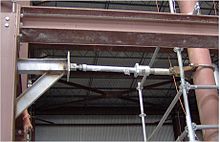Mechanical snubber
A mechanical snubber is a mechanical device designed to protect components from excess shock or sway caused by seismic disturbances or other transient forces.[1] During normal operating conditions, the snubber allows for movement in tension and compression.[2] When an impulse event occurs, the snubber becomes activated and acts as a restraint device. The device becomes rigid, absorbs the dynamic energy, and transfers it to the supporting structure.[3]

The image at right shows an isometric view of one style of mechanical snubber. When a disturbance occurs that exceeds the acceleration threshold of the snubber, the ball screw and drum produce angular momentum to the inertia mass. The inertial resistance of the mass engages the resilient capstan to tighten around a hardened mandrel, which is part of the structural tube. This, in turn, causes restraining force against the rotation of the ball screw. During standard operation, the associated acceleration is far below the threshold limit of the snubber and will not activate the capstan spring.[4]
Applications[]

Process Impulse Events
- water hammer[5]
- tripped valve
- pipe rupture
- protection from overtravel or overstress by reducing the structural response
External impulse events[]
- seismic event (such as an earthquake)[6]
- unexpected failure of adjacent components
- high wind loads
References[]
- ^ Specialty Item Gauges OPUS (Online Piping & Usage Specification), (retrieved 28 September 2010)
- ^ Mechanical Snubber Assemblies Piping Technology & Products, Inc. Catalog, (retrieved 28 September 2010)
- ^ Pipe Supports Explore the World of Piping, (retrieved 28 September 2010)
- ^ Mechanical Snubber Piping Technology & Products, Inc., (retrieved 28 September 2010)
- ^ Can You Believe that Gauge? Workman, Larry, Sept. 23, 2010, (retrieved 28 September 2010)
- ^ Seismic stops for nuclear power plants Anderson, P.H., Oct. 1, 1989, (retrieved 28 September 2010)
- Structural connectors